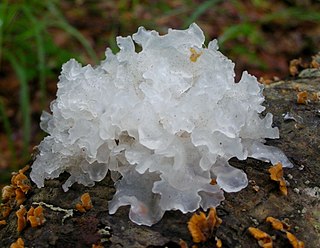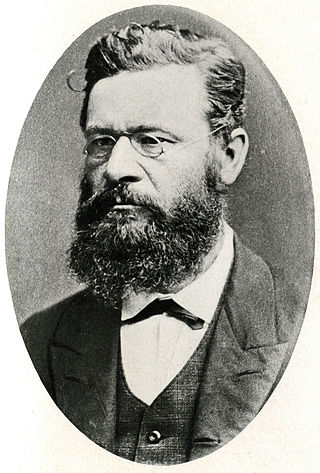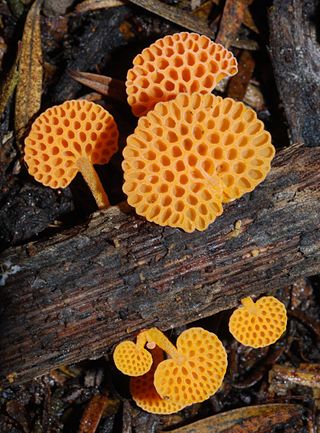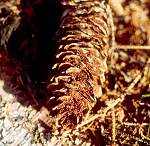Related Research Articles

Phallaceae is a family of fungi, commonly known as stinkhorns, within the order Phallales. Stinkhorns have a worldwide distribution, but are especially prevalent in tropical regions. They are known for their foul-smelling, sticky spore masses, or gleba, borne on the end of a stalk called the receptaculum. The characteristic fruiting-body structure, a single, unbranched receptaculum with an externally attached gleba on the upper part, distinguishes the Phallaceae from other families in the Phallales. The spore mass typically smells of carrion or dung, and attracts flies, beetles and other insects to help disperse the spores. Although there is great diversity in body structure shape among the various genera, all species in the Phallaceae begin their development as oval or round structures known as "eggs". According to a 2008 estimate, the family contains 21 genera and 77 species.

Tremella fuciformis is a species of fungus; it produces white, frond-like, gelatinous basidiocarps. It is widespread, especially in the tropics, where it can be found on the dead branches of broadleaf trees. This fungus is commercially cultivated and is one of the most popular fungi in the cuisine and medicine of China. Tremella fuciformis is commonly known as snow fungus, snow ear, silver ear fungus, white jelly mushroom, and white cloud ears.

Carl Johan Fredrik Skottsberg was a Swedish botanist and explorer of Antarctica.

Petter Adolf Karsten was a Finnish mycologist, the foremost expert on the fungi of Finland in his day, and known in consequence as the "father of Finnish mycology".

Gautieria is a genus of hypogeal fungi in the family Gomphaceae. They form mycorrhizae with various tree species, mostly from the family Pinaceae. Species are present over much of the world's temperate and boreal forest habitats. It is well documented that species from this genera are an important part of the diet of the northern flying squirrel. Also, some Australian marsupials, especially the rat-kangaroos, feed extensively on these fungi. The fungi also benefit from this relationship: not only do the squirrels help to disperse the spores and propagate the species, studies suggest that passage through the digestive tract of a mammal promotes germination of spores.

Onnia is a genus of fungi in the family Hymenochaetaceae. The widely distributed genus contains five species.

Favolaschia is a genus of fungi in the family Mycenaceae. The genus has a widespread distribution, and contains about 50 species. Like the genus Favolus, the name is derived from the Latin favus meaning honeycomb, as the fungi with the large pores on the underside are resembling a honeycomb. The name was first published as a section of the obsolete genus Laschia, which was named after Wilhelm Gottfried Lasch (1787-1863), who was a German apothecary and botanist.

Pucciniastrum is a genus of Basidiomycota fungi. Pucciniastrum species, like all rust fungi, are obligate plant parasites.

Polyozellus is a fungal genus in the family Thelephoraceae, a grouping of mushrooms known collectively as the leathery earthfans. Previously considered a monotypic genus, it now contains the Polyozellus multiplex species complex. The genus name is derived from the Greek poly meaning many, and oz, meaning branch. It is commonly known as the blue chanterelle, the clustered blue chanterelle, or, in Alaska, the black chanterelle. The distinctive fruit body of this species comprises blue- to purple-colored clusters of vase- or spoon-shaped caps with veiny wrinkles on the undersurface that run down the length of the stem.
Shimizuomyces is a genus of fungi within the Clavicipitaceae family.
Lambertella is a genus of fungi in the family Rutstroemiaceae.

The Mixiomycetes are a class of fungi in the Pucciniomycotina subdivision of the Basidiomycota. The class contains a single order, the Mixiales, which in turn contains a single family, the Mixiaceae that circumscribes the monotypic genus Mixia. Only one species has been described to date, Mixia osmundae; this species was originally named Taphrina osmundae by Japanese mycologist Toji Nishida in 1911. It is characterized by having multinucleate hyphae, and by producing multiple spores on sporogenous cells.
Holtermannia is a genus of fungi in the order Holtermanniales. Species produce groups of horn-like gelatinous basidiocarps on wood and have associated yeast states. The genus is distributed in southeast Asia and Brazil, and contains six species.

Amanita rubrovolvata, commonly known as the red volva amanita, is a species of fungus in the family Amanitaceae. First described scientifically by the Japanese mycologist S. Imai in 1939, it is widely distributed in eastern Asia. The fungus produces small to medium-sized mushrooms, with reddish-orange caps up to 6.5 mm (0.26 in) wide. The stems are up to 100 mm (3.9 in) tall, cream above the ring and cream to yellowish below it. The stem ends in a roughly spherical bulb at the base, which is covered with bright orange patches. Neither edibility nor toxicity have been established for the fungus, but it is suspected to be associated with neurological anomalies. Several molecular studies have confirmed the mushroom's classification in the subgenus Amanita of the genus Amanita, along with closely related species such as A. muscaria.
Boninogaster is a genus of fungus in the Hysterangiaceae family. The genus is monotypic, containing the single species Boninogaster phalloides, found in the Bonin Islands of Japan. The genus and species were described by Japanese mycologist Yosio Kobayasi in 1937.

Setchelliogaster is a genus of fungi in the order Agaricales. It is incertae sedis with respect to familial placement within the order, although Kirk and colleagues consider it likely aligned with either the Bolbitiaceae or the Cortinariaceae. Species Fungorum class it as in the Bolbitiaceae family. The genus is widespread in warm, dry areas, and originally contained five species, later degraded to 3 species. It was circumscribed by Czech mycologist Zdeněk Pouzar in 1958.
Poromycena hanedai is a species of agaric fungus in the family Mycenaceae. Found in Japan, the species was first described by Kobayasi in 1951. It is bioluminescent.
Imaia is a fungal genus in the family Morchellaceae found in Japan, and in the Appalachian Mountains of the US. A monotypic genus, Imaia was circumscribed in 2008 by James Martin Trappe and Gábor M. Kovácsto to contain the truffle-like species formerly known as Terfezia gigantea when molecular analysis demonstrated that its DNA sequences were markedly different from those of Terfezia. The fruit bodies of Imaia gigantea are spherical to roughly elliptical to irregular in shape, brown, and usually develop cracks in age. The interior gleba comprises brown pockets of asci separated by white veins. The spores are spherical or nearly so, up to 70 µm long, and enclosed by a thick epispore.
Franz Petrak was an Austrian-Czech mycologist.
References
- ↑ "Kobayasia S.Imai & A.Kawamura, 1958". www.gbif.org. Retrieved 11 May 2022.
- ↑ "シラタマタケ Kobayasia nipponica". きのこじき (in Japanese). Kyoto University Fungi Club. 3 December 2015. Retrieved 25 July 2021.
- ↑ Burkhardt, Lotte (2022). Eine Enzyklopädie zu eponymischen Pflanzennamen [Encyclopedia of eponymic plant names](pdf) (in German). Berlin: Botanic Garden and Botanical Museum, Freie Universität Berlin. doi:10.3372/epolist2022. ISBN 978-3-946292-41-8 . Retrieved January 27, 2022.